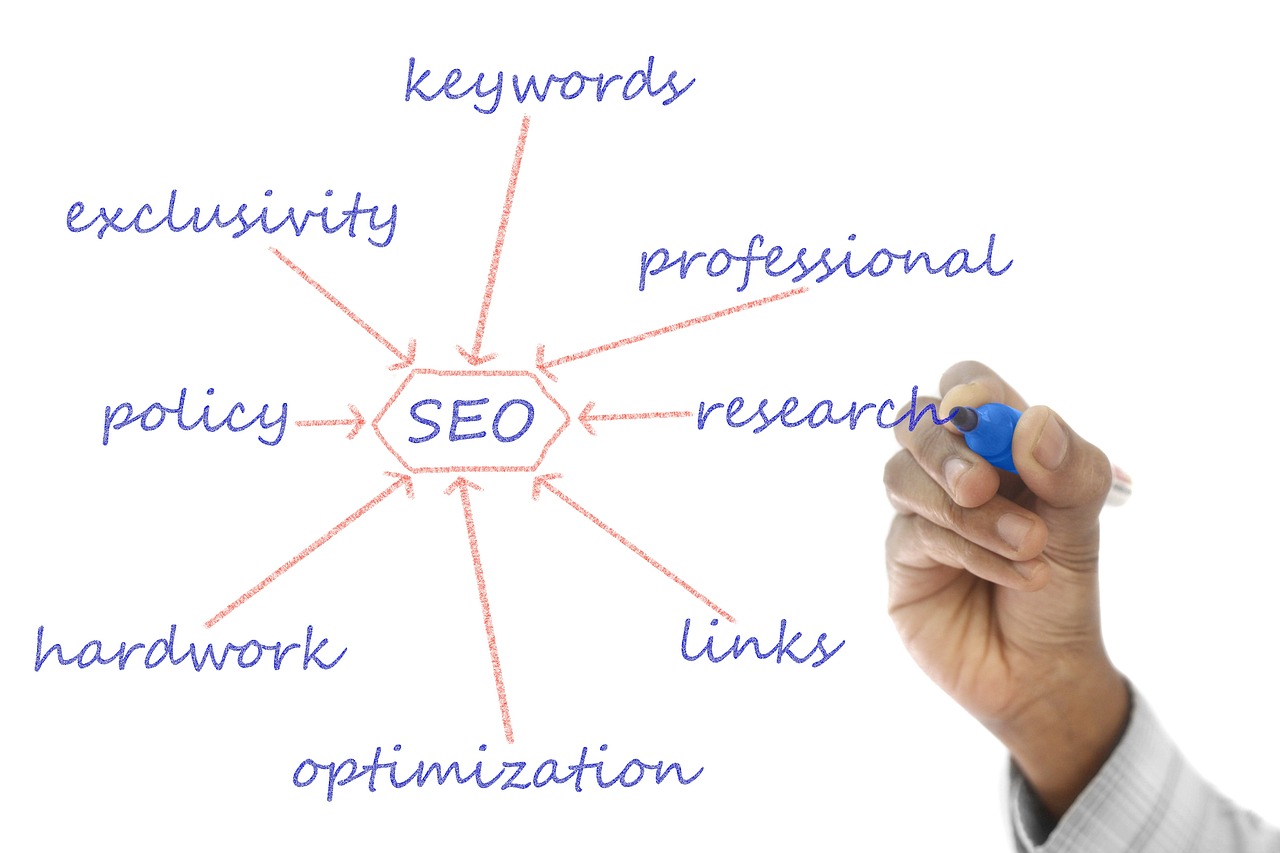Understanding SEO Basics
Search Engine Optimization (SEO) is a critical component of digital marketing that can significantly impact a website’s visibility and ranking in search engine results pages (SERPs). A solid grasp of SEO fundamentals is essential for creating content that not only resonates with readers but also performs well in search rankings. By understanding and implementing SEO best practices, content creators can ensure their work reaches a wider audience and achieves its intended goals.
Keyword Research
Keyword research is the cornerstone of effective SEO strategy. It involves identifying the terms and phrases your target audience uses when searching for information related to your content. Proper keyword research helps align your content with user intent and improves its chances of ranking well in search results.
Tools and techniques for conducting keyword research:
- Google Keyword Planner: Free tool providing keyword ideas and search volume data
- SEMrush: Comprehensive SEO toolkit offering keyword research and competitor analysis
- Ahrefs: Powerful SEO software with extensive keyword research capabilities
- Moz Keyword Explorer: User-friendly tool for discovering and prioritizing keywords
- Google Trends: Analyze the popularity of search queries over time
- Answer The Public: Generates questions and phrases based on seed keywords
- Ubersuggest: Provides keyword suggestions and content ideas
- KeywordTool.io: Offers keyword suggestions from various search engines and platforms
- LSIGraph: Generates Latent Semantic Indexing (LSI) keywords for more comprehensive content
- Soovle: Aggregates suggestions from multiple search engines
Effective keyword research involves a combination of these tools and techniques to identify high-potential keywords that align with your content goals and audience needs.
On-Page SEO Elements
On-page SEO refers to the optimization of individual web pages to rank higher and earn more relevant traffic in search engines. It involves both the content and HTML source code of a page that can be optimized.
| On-Page Element | Optimized Example | Non-Optimized Example |
|---|---|---|
| Title Tag | <title>Best SEO Practices for Content Writers in 2024</title> | <title>SEO Tips</title> |
| Meta Description | <meta name=”description” content=”Discover the top SEO practices for content writers in 2024. Learn how to optimize your content for both search engines and readers.”> | <meta name=”description” content=”SEO tips and tricks”> |
| Header Tags | <h1>SEO Best Practices for Content Writers</h1> | <h1>Welcome to Our Website</h1> |
| URL Structure | example.com/seo-best-practices-content-writers-2024 | example.com/page?id=123 |
| Image Alt Text | <img src=”seo-infographic.jpg” alt=”SEO best practices infographic 2024″> | <img src=”image1.jpg” alt=””> |
Optimizing these on-page elements helps search engines understand your content better and can improve your chances of ranking for relevant keywords.
Writing Engaging Content for Humans

While optimizing for search engines is crucial, the primary goal of content creation should always be to engage and provide value to human readers. Engaging content not only keeps visitors on your site longer but also encourages sharing and linking, which are important factors in SEO. Search engines are increasingly sophisticated in recognizing content that truly resonates with users, making user engagement a key factor in rankings.
Crafting Compelling Headlines
Headlines are often the first (and sometimes only) thing readers see, making them crucial for capturing attention and encouraging clicks. A well-crafted headline can significantly impact your content’s performance in both search results and social media shares.
Characteristics of effective headlines:
- Clarity: Clearly convey the main topic or benefit
- Relevance: Align with the content and target keywords
- Curiosity: Pique interest without being misleading
- Urgency: Create a sense of timeliness when appropriate
- Specificity: Use numbers or specific facts to add credibility
- Emotion: Evoke an emotional response to encourage engagement
- Length: Keep it concise, typically under 60 characters for SEO
- Power words: Incorporate strong, actionable words
- Uniqueness: Stand out from similar content in search results
- Promise: Offer a clear benefit or solution to the reader
By incorporating these elements, you can create headlines that not only attract clicks but also accurately represent your content, improving both SEO performance and user satisfaction.
Using Subheadings and Bullet Points
Proper content structure, including the use of subheadings and bullet points, enhances readability and helps both readers and search engines understand the organization of your content.
| Element | Purpose | Example |
|---|---|---|
| Subheadings (H2, H3, etc.) | Organize content into sections | “Top 5 SEO Strategies for 2024” |
| Bullet Points | List key points or features | • Improve site speed<br>• Optimize for mobile<br>• Create quality backlinks |
| Numbered Lists | Present sequential information | 1. Conduct keyword research<br>2. Optimize on-page elements<br>3. Create engaging content |
| Bold Text | Emphasize important points | User experience is crucial for SEO success |
| Short Paragraphs | Improve readability | 2-3 sentences per paragraph for easy scanning |
Well-structured content not only improves the user experience but also helps search engines understand the hierarchy and importance of information on your page.
Optimizing Content for Search Engines
While creating content for human readers is paramount, optimizing that content for search engines ensures it reaches its intended audience. Content optimization involves strategically incorporating keywords and structuring your content in a way that search engines can easily understand and index.
Keyword Placement and Density
Effective keyword placement is crucial for SEO, but it’s important to maintain a natural flow in your writing. Keyword stuffing, or overusing keywords, can negatively impact both readability and search rankings.
Ideal keyword placements:
- Title tag: Include the primary keyword near the beginning
- First 100 words: Introduce the main topic and primary keyword early
- Headings and subheadings: Use variations of your keywords in H1, H2, and H3 tags
- Throughout the content: Naturally incorporate keywords and variations
- Meta description: Include the primary keyword for better click-through rates
- URL: Use a clean URL structure that includes the primary keyword
- Image alt text: Describe images using relevant keywords
- Conclusion or summary: Reiterate the main topic and primary keyword
- Internal links: Use keyword-rich anchor text when linking to related content
- External links: Link to authoritative sources using relevant anchor text
The key is to use keywords naturally and in context, prioritizing readability and user experience over keyword density.
Optimizing Images and Alt Text
Images play a crucial role in engaging readers and breaking up text, but they also offer opportunities for SEO optimization. Properly optimized images can improve page load speed, enhance user experience, and provide additional ranking signals to search engines.
| Element | Optimized Example | Non-Optimized Example |
|---|---|---|
| File Name | seo-best-practices-infographic.jpg | IMG_12345.jpg |
| Alt Text | “SEO best practices infographic showing key strategies for 2024” | “Image” or left blank |
| File Size | Compressed to 100KB without significant quality loss | Original 1MB file |
| Dimensions | Sized appropriately for display (e.g., 800×600 pixels) | Oversized image scaled down with CSS |
| File Format | WebP or next-gen format for faster loading | Large PNG or uncompressed format |
Optimizing images not only improves your site’s SEO but also enhances accessibility for users with visual impairments who rely on screen readers.
Creating High-Quality, Valuable Content

Search engines increasingly prioritize high-quality, valuable content that provides genuine utility to readers. This focus aligns with the ultimate goal of search engines: to provide users with the most relevant and useful information for their queries. Creating content that truly adds value to your audience is not only beneficial for SEO but also builds trust and authority in your niche.
Providing Comprehensive Information
Comprehensive content that thoroughly covers a topic tends to perform better in search rankings and provides more value to readers. This approach, often referred to as creating “pillar” or “cornerstone” content, involves developing in-depth resources that cover all aspects of a particular topic.
Strategies for researching and including comprehensive information:
- Conduct thorough topic research using academic and industry sources
- Analyze top-ranking content for the target keywords to identify gaps
- Include expert quotes or insights to add authority to your content
- Address common questions and concerns related to the topic
- Provide real-world examples or case studies to illustrate points
- Incorporate data, statistics, and current research findings
- Cover different perspectives or approaches to the topic
- Include actionable tips or step-by-step guides when applicable
- Update content regularly to ensure it remains current and relevant
- Consider multimedia elements like videos or infographics to enhance understanding
By creating comprehensive, authoritative content, you position your website as a valuable resource for both readers and search engines.
Adding Internal and External Links
Effective linking strategies can enhance the value of your content, improve user experience, and boost your SEO efforts. Both internal and external links play important roles in establishing relevance and authority.
| Link Type | Purpose | Example |
|---|---|---|
| Internal Links | Connect related content on your site | Linking to a detailed guide on keyword research from an article about SEO basics |
| External Links | Cite sources and provide additional value | Linking to Google’s official page on mobile-first indexing when discussing mobile optimization |
| Contextual Links | Provide additional information within the content | Using anchor text “keyword research tools” to link to a relevant resource |
| Navigation Links | Help users and search engines explore your site | Including a “Related Articles” section at the end of blog posts |
| Call-to-Action Links | Guide users towards conversion goals | Adding a “Sign Up for Our SEO Newsletter” link within the content |
When implementing linking strategies, focus on providing value to the reader rather than simply trying to manipulate search rankings. High-quality, relevant links can improve user engagement and signal to search engines that your content is informative and well-researched.
For more in-depth guidance on creating high-quality content that ranks well in search engines, you can refer to Google’s Search Quality Rater Guidelines, which provides insights into how Google assesses content quality.
Enhancing User Experience
User experience (UX) has become a critical factor in SEO, as search engines aim to provide users with not only relevant content but also a positive browsing experience. Factors such as page load speed, mobile-friendliness, and ease of navigation all contribute to UX and can significantly impact your search rankings.
Improving Page Load Speed
Page load speed is a crucial factor in both user satisfaction and search engine rankings. Slow-loading pages can lead to high bounce rates and negatively impact your SEO performance.
Tools and techniques for measuring and improving load speed:
- Google PageSpeed Insights: Analyzes page speed and provides optimization suggestions
- GTmetrix: Offers detailed performance reports and recommendations
- Pingdom: Tests website speed from different locations worldwide
- WebPageTest: Provides advanced performance testing options
- Optimize images: Compress and properly size images for the web
- Minify CSS, JavaScript, and HTML: Remove unnecessary characters from code
- Leverage browser caching: Store static files on users’ devices for faster reloading
- Use a Content Delivery Network (CDN): Distribute content across multiple, geographically diverse servers
- Reduce server response time: Optimize server configuration and database queries
- Prioritize above-the-fold content: Load critical content first for faster perceived load times
Implementing these techniques can significantly improve your page load speed, enhancing both user experience and SEO performance.
Ensuring Mobile-Friendliness
With the majority of web traffic now coming from mobile devices, ensuring your content is mobile-friendly is essential for both UX and SEO. Google’s mobile-first indexing means that the mobile version of your website is considered the primary version for ranking purposes.
| Best Practice | Description | Impact |
|---|---|---|
| Responsive Design | Use flexible layouts that adapt to screen size | Ensures consistent experience across devices |
| Large, Readable Text | Use font sizes of at least 16px for body text | Improves readability on small screens |
| Touch-Friendly Elements | Ensure buttons and links are large enough for touch input | Enhances usability for mobile users |
| Optimize Images | Use appropriately sized images for mobile devices | Improves load times and conserves data |
| Avoid Pop-ups | Minimize the use of intrusive interstitials | Prevents frustration and improves user experience |
| Mobile-Optimized Content | Create concise, easily scannable content for mobile readers | Enhances engagement on mobile devices |
| Fast Loading Speed | Optimize for quick loading on mobile networks | Reduces bounce rates and improves user satisfaction |
| Implement AMP | Consider using Accelerated Mobile Pages for fast-loading content | Can improve visibility in mobile search results |
By prioritizing mobile-friendliness, you not only improve your search rankings but also provide a better experience for the growing number of mobile users accessing your content.
Measuring and Analyzing Content Performance
Tracking and analyzing the performance of your content is crucial for refining your SEO strategy and ensuring continuous improvement. By understanding how your content performs, you can make data-driven decisions to enhance its effectiveness and reach.
Using Analytics Tools
Analytics tools provide valuable insights into how users interact with your content, allowing you to measure its success and identify areas for improvement.
Key metrics to track:
- Organic traffic: Number of visitors from search engine results
- Bounce rate: Percentage of single-page visits
- Average time on page: How long users spend engaging with your content
- Page views: Total number of page views for each piece of content
- Conversion rate: Percentage of visitors who complete a desired action
- Keyword rankings: Positions in search results for target keywords
- Click-through rate (CTR): Percentage of users who click on your search result
- Backlinks: Number and quality of external links pointing to your content
- Social shares: How often your content is shared on social media platforms
- Mobile vs. desktop traffic: Distribution of visitors across device types
Tools like Google Analytics, Google Search Console, and various SEO platforms can help you track these metrics and gain insights into your content’s performance.
Making Data-Driven Adjustments
Using the data collected from your analytics tools, you can make informed decisions to improve your content’s SEO performance and user engagement.
| Data Insight | Potential Adjustment | Expected Outcome |
|---|---|---|
| High bounce rate | Improve content relevance or user experience | Increased engagement and time on page |
| Low average time on page | Add more in-depth information or interactive elements | Higher user engagement and potential for conversions |
| Poor keyword rankings | Optimize on-page elements and enhance content depth | Improved search visibility for target keywords |
| Low mobile traffic | Improve mobile optimization and page speed | Increased mobile visitors and better mobile rankings |
| Few social shares | Add social sharing buttons or create more shareable content | Wider content distribution and potential for backlinks |
| Low conversion rate | Refine call-to-action placement or messaging | Improved conversion rates and ROI |
By continually analyzing your content’s performance and making data-driven adjustments, you can enhance its effectiveness in meeting both SEO goals and user needs.
Conclusion
Creating SEO-friendly web content that appeals to both humans and search engines requires a balanced approach that prioritizes user value while implementing technical best practices. By focusing on these key strategies, you can develop content that not only ranks well in search results but also engages and satisfies your audience:
- Conduct thorough keyword research to align content with user intent
- Optimize on-page elements for improved search engine understanding
- Craft compelling headlines and structure content for enhanced readability
- Create comprehensive, high-quality content that provides genuine value
- Implement effective internal and external linking strategies
- Prioritize user experience through fast load times and mobile optimization
- Continuously measure and analyze content performance for ongoing improvement
Remember, the most successful SEO-friendly content is that which genuinely serves the needs of your audience while adhering to search engine best practices. By consistently applying these principles, you can create a strong foundation for long-term SEO success and meaningful engagement with your target audience.




